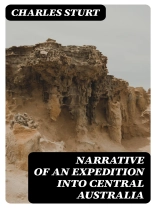In ‘Narrative of an Expedition into Central Australia, ‘ Charles Sturt offers a meticulously detailed account of his journey through the arid heart of Australia during the early 19th century. Employing a vivid and engaging narrative style, Sturt blends personal reflection with scientific observation, immersing readers in the landscape’s harsh realities and the indigenous cultures he encounters. The literary context of this book lies within the genre of exploratory literature, characterized by its quest for knowledge and adventure during an era when Australia was still largely uncharted territory for Europeans. Sturt’s work serves both as an expedition report and a commentary on the challenges faced by early explorers, illuminating the complexities of the land and its people. Charles Sturt, a significant figure in Australian exploration, was motivated by a desire to unveil the mysteries of the Australian interior. His background as a soldier and a surveyor equipped him with the skills and determination necessary for such perilous ventures. Sturt’s curiosity about the continent’s geography and its resources drove him to undertake this arduous expedition, ultimately contributing to his legacy as one of Australia’s pioneering explorers. This book is essential reading for anyone interested in the history of Australian exploration, as it not only chronicles the adventure but also provides profound insights into the challenges of understanding a land defined by its harsh environment and diverse cultures. Sturt’s narrative is not only informative but also deeply reflective, compelling readers to engage with the complexities of history and exploration.
Giới thiệu về tác giả
Captain Charles Sturt (1795-1869) was a British explorer and author, pivotal to the European exploration of Australia. He joined the British army at a young age and was sent to New South Wales in 1827. Sturt undertook significant expeditions into the Australian interior, seeking to uncover the mysteries of the continent’s geography. His contributions to exploration were not purely physical, as he meticulously recorded his journeys, resulting in seminal works of exploration literature. The most notable of his publications is perhaps ‘Narrative of an Expedition into Central Australia’ (1849), which remains a critical resource for understanding the early European perspectives on Australia’s landscape and Indigenous cultures. Sturt’s literary style is marked by detailed observation and analytical descriptions, often imbued with a sense of adventure and the unknown. He is known for his endurance in the face of harsh conditions, and his writing records the trials and observations with a precision that offers insights into the 19th-century colonial mindset and the era’s spirit of discovery. Sturt’s influence extends beyond literature; his explorations proved foundational in mapping the River Murray and his contributions to the colonial expansion of Australia are noteworthy. While his views and actions must be contextualized within his time, Sturt’s work continues to be a reference point for historians and enthusiasts of Australian exploration.












